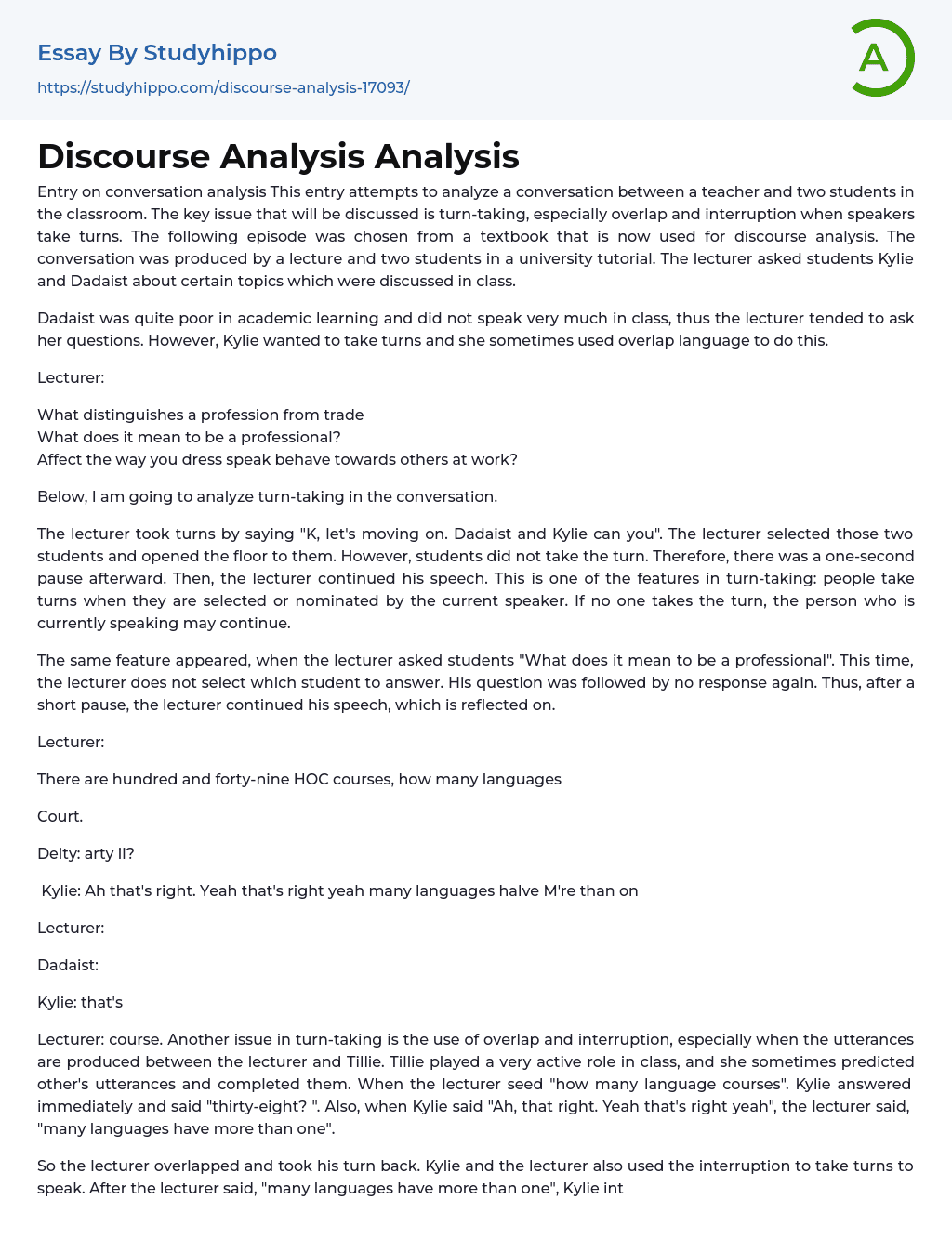The purpose of this text is to examine a classroom conversation between a teacher and two students, with a focus on turn-taking. Specifically, the analysis will explore instances of overlap and interruption when speakers take turns. The selected episode for analysis comes from a textbook used for discourse analysis. This conversation occurred during a university tutorial, where the lecturer questioned Kylie and Dadaist about topics covered in class.
Dadaist had a lack of academic learning and was not very vocal in class, resulting in the lecturer frequently directing questions towards her. However, Kylie desired to alternate turns and occasionally employed overlap language for this purpose.
What distinguishes a profession from trade? What constitutes being a professional? How does it influence your clothing, communication, and behavior towards coworkers at work?
The lecturer began by saying "K, let's
...moving on. Dadaist and Kylie can you." These two students were chosen and given the opportunity to speak. However, they did not respond, resulting in a brief one-second pause. The lecturer then proceeded with his lecture. This scenario demonstrates one aspect of turn-taking, where individuals take their turn when they are specifically chosen or nominated by the current speaker. If no one takes their turn, the current speaker may continue speaking.
The lecture focused on the concept of professionalism. Similar to previous instances, the lecturer sought input from students but received no response. Consequently, after a brief pause, the lecturer continued with a speech influenced by this lack of engagement.
Lecturer:
There are a total of 149 HOC courses, encompassing various languages.
Court.
Who is the deity: arty ii?
Kylie agrees that there are indeed several languages
that have more than one.
The person speaking in this context is a lecturer.
Dadaist:
Kylie: that's
Lecturer: course. Another issue in turn-taking is the use of overlap and interruption, especially when the utterances are produced between the lecturer and Tillie. Tillie played an active role in class, occasionally predicting and completing others' utterances. When the lecturer asked "how many language courses", Kylie immediately answered, saying "thirty-eight?". Additionally, when Kylie said "Ah, that right. Yeah that's right yeah", the lecturer responded by saying "many languages have more than one".
The lecturer and Kylie both interrupted each other during their conversation. The lecturer began by saying that many languages have multiple forms, but Kylie quickly interrupted to say "that's". However, the lecturer did not appreciate the interruption and immediately interrupted Kylie, taking control of the conversation by saying "course".
Kylie used to interrupt and overlap, whereas Dadaist employed back channels like "Ah" and "uh" in class.
Dadaist: suc.
Lecturer: There are thirty-eight language ages.
Dadaist: Ian gauge
Lecturer: However, each language is equivalent to more than one court SE.
The Dadaist enthusiastically agrees, saying "yeah".
The lecturer utilized boundary markers during the conversation, such as using the "K" marker to engage the students and initiate the class. Additionally, at the conclusion of the class, phrases like "All right" and "Okay" were employed as boundary markers. These markers serve to demarcate boundaries between various topics and indicate the progress and upcoming aspects of the class.
Lecturer asks, "Do you remember?"
The dadaist cannot recall.
Lecturer: No? Okay.
During the speech, the lecturer frequently paused, causing moments of silence. These pauses created a problem as participants assumed
that the silence indicated their turn to speak. Despite using the marker "K" to initiate turns, the lecturer did not effectively facilitate successful turn-taking among the students. Additionally, Dadaist, who appeared quiet during class, made use of several back channels. When the lecturer uttered the phrase "But each language is more than en course" on line 6, Dadaist did not take her turn but simply filled the silence by saying "mania".
The purpose of using back channels is to show the speaker that we are paying attention to their message. Student Dadaist utilized back channels during class to indicate her attentiveness. The analysis demonstrates that not all participants in the class take turns equally. Competitive student Tillie frequently interrupted and overlapped in order to take turns. In contrast, weaker student Dadaist struggled to engage in conversation and occasionally used back channels instead of taking the floor.
- Academia essays
- Higher Education essays
- Language Learning essays
- Studying Business essays
- Education System essays
- Study essays
- First Day of School essays
- Scholarship essays
- Pedagogy essays
- Curriculum essays
- Coursework essays
- Studying Abroad essays
- Philosophy of Education essays
- Purpose of Education essays
- Brainstorming essays
- Educational Goals essays
- Importance Of College Education essays
- Brown V Board of Education essays
- The Importance Of Higher Education essays
- Online Education Vs Traditional Education essays
- Academic And Career Goals essays
- Academic Integrity essays
- Brown Vs Board Of Education essays
- Distance learning essays
- Technology in Education essays
- Vocabulary essays
- Writing Experience essays
- Importance of Education essays
- Early Childhood Education essays
- Academic Degree essays
- Academic Dishonesty essays
- School Uniform essays
- Academic writing essays
- Cheating essays
- Bachelor's Degree essays
- MBA essays
- College Life essays
- Grade essays
- Diploma essays
- Phonology essays
- Sentence essays
- Filipino Language essays
- Pragmatics essays
- Millennium Development Goals essays
- History Of Education essays
- Graduate School essays
- Middle School essays
- School essays
- Special Education essays
- University essays




